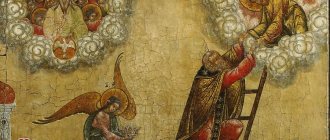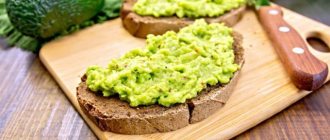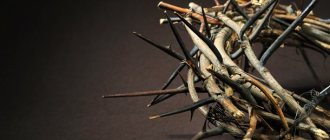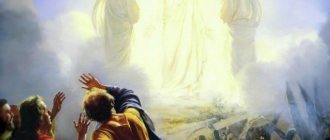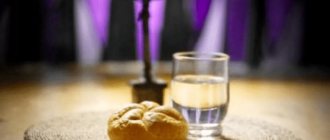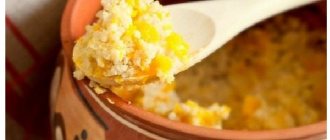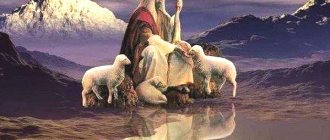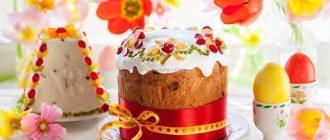Lent is coming to an end. At the end of this week, Orthodox Christians will celebrate one of the most important religious holidays - Bright Sunday of Christ. Easter is the most revered and joyful holiday in the church calendar. A holiday that symbolizes the renewal and salvation of the world and man, the triumph of life over death, good over evil and light over darkness.
In the nutrition calendar, the last week of Lent has some features. So, on Monday, Tuesday, Wednesday and Saturday, dry food is allowed; on Thursday, hot food with butter is allowed. On Good Friday, complete abstinence from eating until the removal of the Shroud is required; dry eating is allowed in the evening.
We offer you a possible option for dishes that can be prepared this week.
Lenten carrot salad with oranges
| • Carrots - 2 pcs. • Orange – 1 pc. • Raisins - a handful • Sesame seeds - 2 tablespoons • Vegetable oil to taste |
1. Wash, peel and grate the carrots.
2. Peel and cut the orange, removing seeds and rough white membranes. 3. Rinse raisins in warm water. 4. Place carrots on a plate, sprinkle with orange slices, raisins and sesame seeds. Drizzle with vegetable oil and serve immediately. Detailed step-by-step
salad
Cheese week: what it means and existing traditions
Cheese week is the last Sunday before the start of Lent, and it is on this day that cheese week ends, which has another name - Maslenitsa. During these seven days you cannot eat meat.
The word week in this phrase has a completely different meaning - it means the day of the week, that is, Sunday. Raw food means that you can eat dairy products, eggs and fish, but meat is already prohibited. And the meaning behind this is that these products seem to be released to make it easier to abstain during fasting. Thanks to this preparation, the human body makes it easier to switch to lean foods.
Lenten rolls with vegetables
| • Nori seaweed - 4 sheets • Avocado - 1 pc. • Kohlrabi - 1 pc. • Cucumber – 2 pcs. • Salad • Salt to taste • Lemon juice to taste |
1. Wash the kohlrabi, peel and grate on a medium grater.
Season the resulting mass with lemon juice and salt. 2. Cut the avocado in half and remove the bone. 3. Wash the cucumbers and cut them together with the avocado into thin slices. 4. Place the nori sheet on the kitchen board. Spread a layer of kohlrabi on top (it will act as boiled rice). Place lettuce leaves and slices of cucumber and avocado on the kohlrabi. 5. Roll the lean dish like a regular Japanese roll. Press the edge lightly with your hands. 6. Cut each resulting roll into 6 pieces with a sharp thin knife. Detailed step-by-step recipe
for lean rolls with vegetables
Preparatory period for Lent
(from February 13; ends with Forgiveness Sunday, March 6).
• Week of the Publican and the Pharisee ( Luke 18:10–14) – February 13.
“Continuous” week (no fasting on Wednesday and Friday) (February 14 – February 19).
• Sunday of the Prodigal Son (Luke 15:11–32) – February 20.
• Ecumenical parental (meat-free) Saturday – February 26th.
• Meat week ( last
about the Last Judgment (Matthew 25:31–46) – February 27.
Cheese week (Maslenitsa), “continuous” (February 28 – March 5).
• Cheese week . Memories of Adam's exile. Forgiveness Sunday (Matt. 6:14–21) – March 6.
***
Cucumber and avocado soup
| • Avocado – 4 pcs. • Lemon - ½ pc. • Cucumbers - 4 pcs. • Salt - to taste • Ground black pepper to taste • White wine vinegar - 1 tablespoon • Olive oil - 2 tablespoons • Red bell pepper - 1 pc. • Yellow bell pepper - 1 pc. • Tomatoes - 1 pc. • Onion – 1 head • Parsley – 4 stalks • Mineral water to taste |
1. Remove seeds and skin from the avocado.
2. Cut the peel off three cucumbers. If the seeds are very large, remove them. 3. Cut the peeled avocados and cucumbers into large pieces and place in a blender. Add salt, pepper, olive oil, vinegar, lemon juice. Grind to a thick puree. 4. Taste and dilute with water to the consistency you like. 5. Cut the peppers, cucumber and tomato into small cubes. 6. Place some of the chopped vegetables into plates and pour chilled soup. Decorate with herbs and other chopped vegetables. Detailed step-by-step
soup
Bright Sunday
Lent in the Christian religion has two special meanings. Believers repeat the wanderings of Jesus Christ in the desert, during which he was purified physically and spiritually before fulfilling the Great Mission, this also includes concern for the salvation of his own soul and the purification of his body.
People come to this multi-day ritual only on a voluntary basis, with full awareness of the need to undergo it. The menu of each week depends on the requirements, on some days they are more severe, on others (for example, on major holidays), some relaxation is given.
Holy Week is the last seven steps that must be passed through patiently and with dignity, without violating the canons, if the purpose of fasting is to enter physically and spiritually prepared into the most significant holiday in Orthodoxy and rejoice at the Resurrection of the Lord.
Cucumber and celery smoothie
| • Cucumber – 1 pc. • Celery (stem) - 2 stalks • Lemon juice - 1 tsp. • Parsley - 2-3 sprigs • Salt and pepper - to taste • Still mineral water - optional |
1. Peel the celery stalks and cut into slices, cut the cucumber into strips.
2. Puree the cucumber in a blender first. Then add celery to the blender bowl. 3. Add parsley. You can replace it with lettuce leaves, spinach, sorrel, arugula - whatever your heart desires. 4. A little lemon juice will add a slight sourness to the smoothie. 5. Salt and pepper are also very appropriate, add them to taste. 6. Beat all the drink ingredients again until smooth. If you like thin smoothies, add some still mineral water. Detailed step-by-step
smoothie
Relaxations in fasting
Along with the question of what can be eaten during Holy Week before Easter, believers are often interested in the following:
- Who is allowed to relax in fasting?
- Should children fast?
- Is it possible for a person suffering from diseases of the digestive system not to participate in fasting?
Here it is necessary to immediately make a reservation that the church has long determined the norm for fasting: restrictions on food are not allowed if this is harmful to human health. Each of us is obliged to take care not only of our soul, but also of our body. After all, if the soul is pure, but the body is not in order, then living in such a state will also not be easy.
Pregnant women, children and people in poor health
Suppression of one's natural needs can also be harmful in a psychological sense. A person becomes angry and can take it out on loved ones. And then it turns out that fasting leads to evil in the most literal sense of the word.
Is such a feat necessary? The answer is clear: no, fasting should only work for good. And pregnant women, children and people with poor health should not risk their bodies.
Relaxations for beginners
What should a person do if he has just started fasting? Of course, it will be especially difficult for him: he lacks experience, lacks patience and fortitude, which is quite normal. We, for example, cannot immediately get behind the wheel and drive. Everything takes time - no one has repealed this law.
The clergy believe that certain concessions for beginners are allowed. However, all questions, including what can be eaten in the last week before Easter and what cannot, should be discussed with the priest.
A conversation with the priest will help not only clarify the situation, but also recharge you with the right attitude. This one is almost like sharing something treasured with your best friend.
Sometimes a person needs very little: a few minutes of attention and a kind word. And in the case of spiritual issues, the importance of these gifts only increases.
If you haven't started fasting from the very beginning
This is another frequently asked question along with what you can eat in the last week of Lent before Easter. It seems that if a person did not initially fast, then does he have the right to join the ritual in the last (Holy) week? That is, how fair is this, and is there any sin in this?
In fact, everyone acts according to their own conscience. And even if a person (whether he is a beginner or not) begins to fast only in the last days before Holy Resurrection, the church welcomes such a decision. Sharing the sufferings of Christ in memory of the Savior is a pleasant duty, and not a heavy cross that should frighten and dishearten.
Thus, fasting is not a ritual, not an empty custom that a person observes simply because “it’s necessary.” Each of us is a rational being endowed with freedom of choice.
Therefore, the decision to fast should be meaningful and personal. This means that you cannot do without a positive attitude and blessing in this matter, as in most others.
Lenten buckwheat porridge with vegetables in a pot
| • Buckwheat - 0.5 cups • Carrots - 1 pc. • Zucchini - 1 pc. • Onion - 2 pcs. • Tomatoes - 3–4 pcs. • Champignons – 150 g • Salt, pepper to taste |
1. Rinse buckwheat, add water, add salt and boil until half cooked.
2. Peel the carrots and grate them on a coarse grater. Cut the zucchini into thin strips. Place the tomatoes in boiling water for a minute, peel the skin and cut the pulp into cubes. 3. Heat a frying pan with vegetable oil and fry the vegetables until soft. 4. Cut the champignons into thin slices, peel and chop the onion. Fry the mushrooms along with the onions in vegetable oil until golden brown. 5. Mix vegetables with mushrooms and buckwheat porridge, season to taste. 6. Place the porridge in pots, pour in a little water and place in an oven preheated to 200 degrees. Bring to readiness, cool slightly and serve. Detailed step-by-step recipe
for buckwheat porridge . Bon appetit!
You will find even more recipes for Lenten and other dishes here
The sacred meaning of fasting
Fasting is one of the main church customs. This is a time when believers consciously, voluntarily abstain from certain animal products and certain other foods. Through this abstinence people express their obedience and respect to God and the church.
Of course, the central place in the year is occupied by Lent, which is both the longest and the strictest (especially if we talk about the last days of Holy Week, when food is actually prohibited).
But what is the point of fasting? Why does it occupy a special place in the life of every Christian who strives to keep the commandments of God and the instructions of the church? Interestingly, Christ also fasted, for a full 40 days and 40 nights, after which he experienced an incredibly strong feeling of hunger and “was hungry,” as it is written in the Bible.
It is known that after fasting, a very difficult event awaited the Savior - he had to undergo three tests from the evil spirit, which were incredibly insidious. However, Christ managed to resist, including because he had already tested his spiritual strength while abstaining from food.
Thus, by fasting, a person undergoes his own test, and thanks to this, his spiritual strength increases many times over.
Abstinence is always a voluntary act. And in a broad sense, fasting can be associated with temporarily depriving oneself of any pleasure - TV, intimacy, parties, etc. And such self-control really leads to successful results.
For example, we have to deny ourselves a lot while studying or working. Sometimes you have to endure hardships in union with loved ones, but the trials you go through together only bring you closer. And in general, are there victories without a fight?
And another striking example is a diet to keep the body healthy and beautiful. Yes, a person can deny himself nothing, eat sweets, fried meat, pies and any other dishes that are truly incredibly tasty.
But what's the downside? Loss of external attractiveness, excessive stress on the stomach with corresponding consequences.
Of course, a diet is not a fast, but there are certainly similarities between them: in both cases, a person voluntarily pacifies his natural need. But the goals are different - the diet is designed to maintain beautiful shape, as well as to improve the health of the body.
Fasting is service to the Lord. Both goals are wonderful and undeniably motivating. They just differ from each other in essence.
As for Lent, at this time believers want to show their special respect to the Savior, as if to share his suffering (especially in the last week before Easter).
After all, how can you feel the pain of another person? Everyone can understand suffering. But only he will be able to feel for his loved one who sincerely shares his problems with him.
Maundy Tuesday
On Great Tuesday we remember how Christ came to the Temple of Jerusalem and preached for the last time to the people, denounced the scribes and Pharisees, talked and spoke in parables: about tribute to Caesar, about the resurrection of the dead, about the Last Judgment, about ten virgins and about talents.
Giotto. Scrovegni Chapel, fresco. Photo: Commons.wikimedia.org
The Pharisees were preparing a trap for Jesus, wanting either to get a reason to report him to the Roman authorities, or to discredit him in the eyes of the Jews. They asked: “What do you think? Is it permissible to give tribute to Caesar or not?” (John 8:49) If Christ had answered “yes”, and the Pharisees would have accused him of supporting the Roman authorities, the answer “no” could have become a pretext to declare Jesus a rebel.
But Christ ordered to show them a Roman denarius and asked what they saw on it. The emperor was depicted on the coin, and the Pharisees replied that it was Caesar*. We know Christ’s answer well: “Render therefore the things that are Caesar’s to Caesar, and the things that are God’s to God” (Matthew 22:21).
Article on the topic
Tofu: how to replace protein during Lent
Maundy Thursday
On Thursday of Holy Week, during the divine service, they remember the most important gospel event: the Last Supper, at which the Lord established the sacrament of Holy Communion (Eucharist).
Leonardo da Vinci. Last Supper, 1495-1498. Photo: Commons.wikimedia.org
The Gospel of Matthew says that during the meal, Jesus took bread, blessed it and, breaking it, gave it to the disciples with the words: “Take, eat: this is My Body.” Then he gave the apostles the cup and said: “Drink from it, all of you, for this is My Blood of the New Testament, which is shed for many for the remission of sins.”
That is why on Maundy Thursday Christians partake of the Holy Mysteries of Christ by eating consecrated bread and wine.
During the Last Supper, Christ told his disciples that one of them would betray him. So it will be: Judas Iscariot, who had already sold his teacher for 30 pieces of silver, will show Him to the guards at night in the Garden of Gethsemane, coming up and kissing Him.
Article on the topic
Lent is a time of worries. What rules did Muscovites follow before the revolution?
On the morning of Maundy Thursday, the Liturgy of St. Basil the Great is served in churches, during which the rite of consecration of the world is performed. After the liturgy, there is the rite of washing the feet: the bishop, following the example of Christ, who washed the feet of his disciples, washes the feet of 12 clergy as a sign of humility.
On Thursday evenings they serve Matins of Good Friday (Service of the Twelve Gospels). During this service, 12 passages from the Gospels are read, which tell the story of the last hours of Christ's life, from his conversation with his disciples and prayer in the Garden of Gethsemane to his crucifixion on Calvary and burial in the tomb prepared by Joseph of Arimathea.
On Maundy Thursday, clergy and parishioners stand in the church with lit candles in their hands as a sign that glory and greatness did not abandon Christ during his suffering. After the service, the candles are not extinguished, but are brought home and kept lit in lamps until Easter.
From Monday to Thursday, the penitential canon of St. Andrew of Crete is read every evening in churches.
LiveInternetLiveInternet
Monday, April 10, 2021 08:39 + to quote book
|
|
[/td]
| Categories: | Orthodoxy. |
Tags:
Orthodoxy
Cited 4 times Liked by: 28 users
Like share
0
Like
- 28
I liked the post - Quoted
- 0
Saved
- Add to quote book
- 0
Save to links
Liked28
0
Christ's Resurrection
On the seventh day of Holy Week, Orthodox Christians celebrate the Resurrection of Christ from the dead. Jesus Christ died on the cross on Friday at about three o'clock in the afternoon. On the third day after the burial of Christ, early in the morning, several women (Mary Magdalene, Joanna, Salome and Mary of James and others with them) carried the incense they had bought to anoint the body of Jesus. Walking to the burial place, they grieved: “Who will roll away the stone from the tomb for us?” - because, as the Evangelist explains, the stone was great. But the stone had already been rolled away and the tomb was empty. This was seen by Mary Magdalene, who came first to the tomb, and by Peter and John, whom she called, and by the myrrh-bearing women, to whom the Resurrection of Christ was announced by a young man sitting at the tomb in luminous robes. The four Gospels describe this morning in the words of various witnesses who came to the tomb one after another. There are also stories about how the risen Christ appeared to the disciples and talked with them.
Alexander Andreevich Ivanov. The appearance of Christ to Mary Magdalene after the Resurrection. 1835. Photo: Commons.wikimedia.org
On the night of Easter, the Acts of the Apostles are read in the church. Believers in festive clothes come to churches on the evening of Holy Saturday, at approximately 22:00. At the beginning of twelve, the Midnight Office begins - a service at which the canon of Holy Saturday is sung. At the end, the priests transfer the Shroud from the middle of the temple to the altar, where it remains until the Feast of the Ascension of the Lord (June 13, 2014) - in memory of the forty days of Christ’s stay on earth after His Resurrection.
Caesar's profile was on the denarius. Taxes in Judea were paid with Roman money. And the Jews donated special temple money to God in the temple, which they exchanged for Roman money from the money changers sitting right there.
